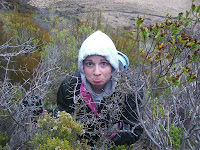Matagouri (Discaria toumatou) is the most widespread and common native shrub in New Zealand. It is also the only native plant with thorns. It is characterized by a branched and tangled array of thorns. It can grow up to five meters tall. It is considered a weed in parts of the South Island but is considered endangered in the North Island. This species is drought-tolerant and many farmers on the South Island will burn it or spray it. It’s also known as the Wild Irishman. See photos of this thorny mass below.


Dracophyllum filifolium is the other thorny plant we encountered. This plant had long, slender, needlelike leaves that had pointed barbs on the ends. Though this shrub would seem to be a monocot at first glance, it is actually a dicot. Dracophyllum is found in a variety of different species that are located throughout much of New Zealand. This shrub that we found seemed to be located at higher elevations compared to the Matagouri, which was observed at both low and higher elevations. See photos below. (Click to enlarge)



No comments:
Post a Comment